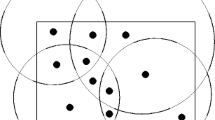Abstract
We consider the problem of counting a set of discrete point targets using a network of sensors under a minimalistic model. Each sensor outputs a single integer, the number of distinct targets in its range, but targets are otherwise indistinguishable to sensors: no angles, distances, coordinates, or other target-identifying measurements are available. This minimalistic model serves to explore the fundamental performance limits of low-cost sensors for such surveillance tasks as estimating the number of people, vehicles or ships in a field of interest to first degree of approximation, to be followed by more expensive sensing and localization if needed. This simple abstract setting allows us to explore the intrinsic complexity of a fundamental problem, and derive rigorous worst-case performance bounds. We show that even in the 1-dimensional setting (for instance, sensors counting vehicles on a road), the problem is non-trivial: target count can be estimated within relative accuracy of factor \(\sqrt{2}\) and this is the best possible in the worst-case. We then address additional questions related to constructing feasible target placements, and noisy counters. In two dimensions, the problem is considerably more complicated: a constant-factor approximation is impossible. Our algorithms and analysis can easily handle some of the non-idealities of real sensors, such as asymmetric ranges and non-exact target counts.
This research was supported in part by the National Science Foundation under grants CNS-0626954 and CCR-0514738.
Preview
Unable to display preview. Download preview PDF.
Similar content being viewed by others
References
Arora, A., Dutta, P., Bapat, S., Kulathumani, V., et al.: A line in the sand: A wireless sensor network for target detection, classification, and tracking. Computer Networks (2004)
Aslam, J., Butler, Z., Constantin, F., Crespi, V., et al.: Tracking a moving object with a binary sensor network. In: SENSYS (2003)
Lazos, L., Poovendran, R., Ritcey, J.: Probabilistic detection of mobile targets in heterogeneous sensor networks. In: IPSN (2007)
Oh, S., Sastry, S.: Tracking on a graph. In: IPSN (2005)
Shrivastava, N., Mudumbai, R., Madhow, U., Suri, S.: Target tracking with binary proximity sensors: fundamental limits, minimal descriptions, and algorithms. In: SENSYS (2006)
Singh, J., Kumar, R., Madhow, U., Suri, S., et al.: Tracking multiple targets using binary proximity sensors. In: IPSN (2007)
Cai, Q., Aggarwal, J.K.: Tracking human motion using multiple cameras. In: ICPR (1996)
Nguyen, N., Venkatesh, S., West, G., Bui, H.: Multiple camera coordination in a surveillance system (2003)
Stauffer, C., Eric, W., Grimson, L.: Learning patterns of activity using real-time tracking. IEEE Transaction on Pattern Analysis Machine Intelligence (2000)
Oh, S., Chen, P., Manzo, M., Sastry, S.: Instrumenting wireless sensor networks for real-time surveillance. In: International Conference on Robotics and Automation (2006)
Cormen, T., Lieserson, C., Rivest, R., Stein, C.: Introduction to algorithms (2004)
Collins, R., Lipton, A., Fujiyoshi, H., Kanade, T.: Algorithms for cooperative multisensor surveillance. Proceedings of the IEEE 89, 1456–1477 (2001)
Zaidi, Z., Mark, B.: A mobility tracking model for wireless ad hoc networks. In: IEEE WCNC (2003)
Chen, H., Kirubarajan, T., Bar-Shalom, Y.: Multiple target tracking with multiple finite resolution. In: 5th International Conference on Information Fusion (2002)
Hwang, I., Roy, K., Balakrishnan, H., Tomlin, C.: A distributed multiple-target identity management algorithm in sensor networks. In: IEEE Conference on Decision and Control (2004)
Jung, B., Sukhatme, G.: Tracking targets using multiple robots: The effect of environment occlusion. Autonomous Robots (2002)
Liu, J., Liu, J., Reich, J., Cheung, P., et al.: Distributed group management for track initiation and maintenance in target localization applications. In: Zhao, F., Guibas, L.J. (eds.) IPSN 2003. LNCS, vol. 2634, pp. 113–128. Springer, Heidelberg (2003)
Mechitov, K., Sundresh, S.: Cooperative tracking with binary-detection sensor networks. In: SENSYS (2003)
Oh, S., Hwang, I., Roy, K., Sastry, S.: A fully automated distributed multiple-target tracking and identity management algorithm. In: AIAA Guidance, Navigation, and Control Conference (2005)
Rachlin, Y., Negi, R., Khosla, P.: Sensing capacity for discrete sensor network applications. In: IPSN (2005)
Shin, J., Guibas, L., Zhao, F.: A distributed algorithm for managing multi-target identities in wireless ad-hoc sensor networks. In: Zhao, F., Guibas, L.J. (eds.) IPSN 2003. LNCS, vol. 2634, pp. 223–238. Springer, Heidelberg (2003)
Gfeller, B., Mihalak, M., Suri, S., Vicari, E., et al.: Counting targets with mobile sensors in an unknown environment. In: Kutyłowski, M., Cichoń, J., Kubiak, P. (eds.) ALGOSENSORS 2007. LNCS, vol. 4837, pp. 32–45. Springer, Heidelberg (2008)
Fang, Q., Zhao, F., Guibas, L.: Counting targets: Building and managing aggregates in wireless sensor networks. PARC Technical Report (2002)
Yang, D., Gonzalez-Banos, H., Guibas, L.: Counting people in crowds with a real-time network of image sensors. In: International Conference on Computer Vision (2003)
Baryshnikov, Y., Ghirst, R.: Target enumeration in sensor networks via integration with respect to euler characteristic (2007)
Author information
Authors and Affiliations
Editor information
Editors and Affiliations
Rights and permissions
Copyright information
© 2008 Springer-Verlag Berlin Heidelberg
About this paper
Cite this paper
Gandhi, S., Kumar, R., Suri, S. (2008). Target Counting under Minimal Sensing: Complexity and Approximations. In: Fekete, S.P. (eds) Algorithmic Aspects of Wireless Sensor Networks. ALGOSENSORS 2008. Lecture Notes in Computer Science, vol 5389. Springer, Berlin, Heidelberg. https://doi.org/10.1007/978-3-540-92862-1_4
Download citation
DOI: https://doi.org/10.1007/978-3-540-92862-1_4
Publisher Name: Springer, Berlin, Heidelberg
Print ISBN: 978-3-540-92861-4
Online ISBN: 978-3-540-92862-1
eBook Packages: Computer ScienceComputer Science (R0)




